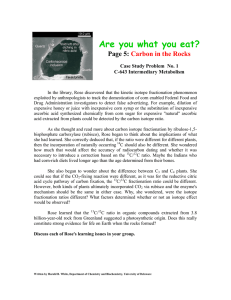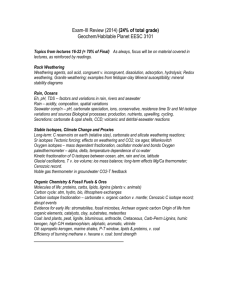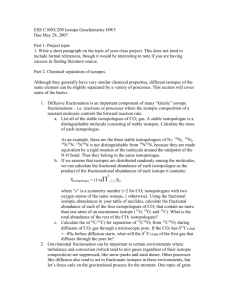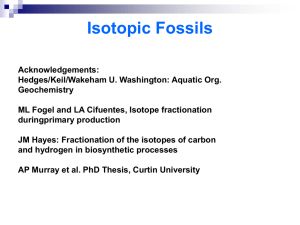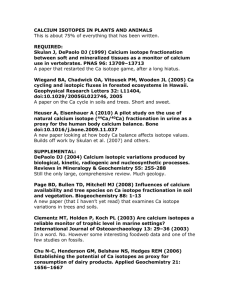Chapter 4 Problems.doc
advertisement
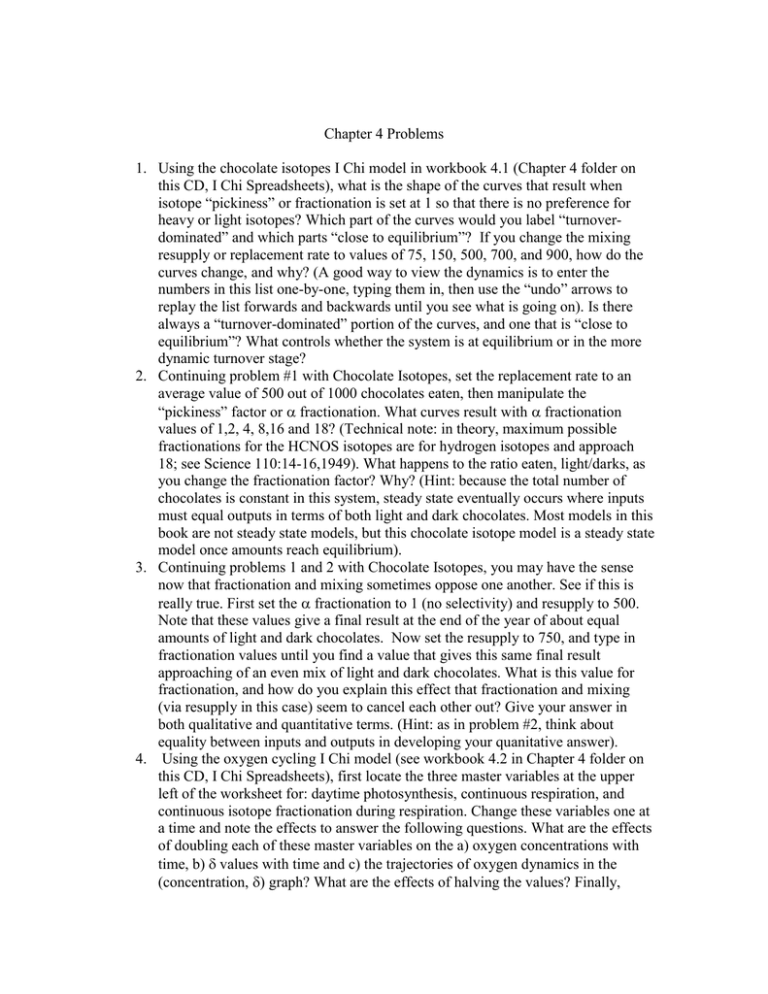
Chapter 4 Problems 1. Using the chocolate isotopes I Chi model in workbook 4.1 (Chapter 4 folder on this CD, I Chi Spreadsheets), what is the shape of the curves that result when isotope “pickiness” or fractionation is set at 1 so that there is no preference for heavy or light isotopes? Which part of the curves would you label “turnoverdominated” and which parts “close to equilibrium”? If you change the mixing resupply or replacement rate to values of 75, 150, 500, 700, and 900, how do the curves change, and why? (A good way to view the dynamics is to enter the numbers in this list one-by-one, typing them in, then use the “undo” arrows to replay the list forwards and backwards until you see what is going on). Is there always a “turnover-dominated” portion of the curves, and one that is “close to equilibrium”? What controls whether the system is at equilibrium or in the more dynamic turnover stage? 2. Continuing problem #1 with Chocolate Isotopes, set the replacement rate to an average value of 500 out of 1000 chocolates eaten, then manipulate the “pickiness” factor or fractionation. What curves result with fractionation values of 1,2, 4, 8,16 and 18? (Technical note: in theory, maximum possible fractionations for the HCNOS isotopes are for hydrogen isotopes and approach 18; see Science 110:14-16,1949). What happens to the ratio eaten, light/darks, as you change the fractionation factor? Why? (Hint: because the total number of chocolates is constant in this system, steady state eventually occurs where inputs must equal outputs in terms of both light and dark chocolates. Most models in this book are not steady state models, but this chocolate isotope model is a steady state model once amounts reach equilibrium). 3. Continuing problems 1 and 2 with Chocolate Isotopes, you may have the sense now that fractionation and mixing sometimes oppose one another. See if this is really true. First set the fractionation to 1 (no selectivity) and resupply to 500. Note that these values give a final result at the end of the year of about equal amounts of light and dark chocolates. Now set the resupply to 750, and type in fractionation values until you find a value that gives this same final result approaching of an even mix of light and dark chocolates. What is this value for fractionation, and how do you explain this effect that fractionation and mixing (via resupply in this case) seem to cancel each other out? Give your answer in both qualitative and quantitative terms. (Hint: as in problem #2, think about equality between inputs and outputs in developing your quanitative answer). 4. Using the oxygen cycling I Chi model (see workbook 4.2 in Chapter 4 folder on this CD, I Chi Spreadsheets), first locate the three master variables at the upper left of the worksheet for: daytime photosynthesis, continuous respiration, and continuous isotope fractionation during respiration. Change these variables one at a time and note the effects to answer the following questions. What are the effects of doubling each of these master variables on the a) oxygen concentrations with time, b) values with time and c) the trajectories of oxygen dynamics in the (concentration, ) graph? What are the effects of halving the values? Finally, using the original values for the three variables, what is the effect of changing the fourth master variable, the isotope value of oxygen from photosynthesis, from 0 to -10o/oo and then from 0 to +10o/oo? Considering the overall results from this exercise, would you agree or disagree with the idea that isotopes can help constrain ideas about how oxygen is produced and consumed in aquatic systems? Explain your answer. 5. This problem addresses whether oxygen isotope measurements are really useful for studying oxygen dynamics. Originally, oxygen isotope models were developed for the ocean to study production/respiration ratios or P/R (Global Biogeochemical Cycles 1:49-59, 1987). When P/R = 1, production and respiration are balanced and there is no net change in oxygen concentrations. But when photosynthesis due to algal growth is greater than respiration, oxygen accumulates and P/R>1. Here we compare two growth scenarios where P/R>1, considering only the first 12 hours when oxygen is increasing. Using the oxygen cycling I Chi model in workbook 4.2 (see Chapter 4 folder on this CD, I Chi Spreadsheets), change the fractionation factor to 15o/oo, the value used in the first modeling study cited above in this problem. Using your cursor to click on the graphs in the workbook, what are the values at 12 hours (0.5 days) for oxygen concentrations and 18O values? What is P/R at 12 hours? Next change the P rate from 4 to 6 and R rate from 2 to 4 in the workbook and repeat your observations about oxygen concentrations, 18O, and P/R at 12 hours (0.5 days). Make a table of your results for both scenarios showing initial and 12 hour values for oxygen concentrations, 18O, and calculated P/R. Now that you have compiled the results, look back at the experiment and answer these questions: Can you use the oxygen concentrations alone to estimate the P/R ratio, the rates of photosynthesis and the rates respiration? If not, does adding the 18O information help with these three estimates? 6. Following the step-by-step approach I Chi modeling approach outlined in section 4.4 and in the Workbook 4.4 (Chapter 4 folder on this CD, I Chi Spreadsheets), develop a spreadsheet model for CO2 dynamics in a closed greenhouse full of large plants maintained 24 hours a day in well-lit conditions. The plants fix CO2 and remove it from the atmosphere, but also respire CO2 and return CO2 to the atmosphere. Incorporate the following initial assumptions into your model: a) the initial 13C value of CO2 is -8o/oo, the current 13C value of CO2 in the atmosphere, b) the initial concentration of CO2 is 375 ppm, c) during photosynthetic CO2 uptake, plants fractionate by 20o/oo and use a constant amount of 5 ppm CO2 per hour, and d) during continuous respiration, plants do not fractionate carbon isotopes but add back CO2 with a constant value of -28o/oo at a rate of 4 ppm per hour. What are the predicted concentrations and isotope values after 10 days, at 240 hours? Show your spreadsheet model and graphs of your time-course prediction for CO2 concentrations and isotope values. Also, compare your model to the oxygen model of problem 4 and sections 4.2-4.5. What are the similarities and differences between the oxygen and carbon dioxide models? 7. Use the gain-loss model for cows presented in section 4.7 and modify it to explore carbon isotope dynamics for cows feeding in a pasture. Assume that the fractionation involved in carbon loss, primarily as respired CO2, is 1o/oo, but that there is no fractionation during assimilation of carbon from the diet. (This same assumption of no fractionation during assimilation was discussed in section 4.7 for N assimilation, and also likely applies to carbon isotopes). Use the spreadsheet cow model in Workbook 4.7a (Chapter 4 folder on this CD, I Chi Spreadsheets) to work through various growth and starvation scenarios for carbon, parallel to those given already for nitrogen. If animals in nature generally have carbon isotope compositions about +0.5o/oo vs. their diets, what kind of gain-loss dynamics do the models predict for these free-living animals? Why?

